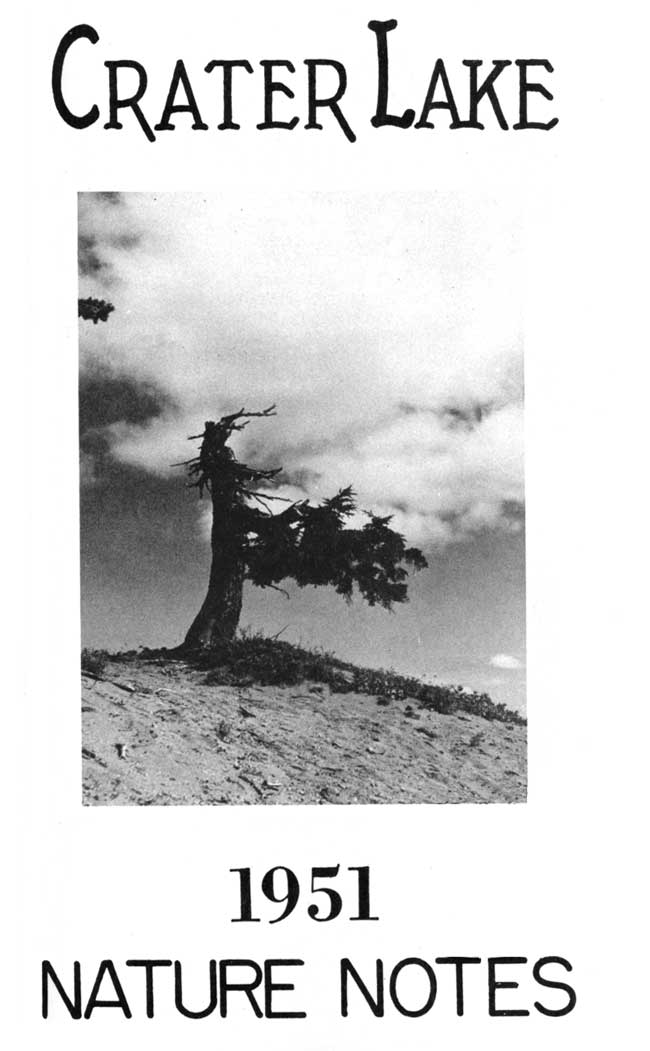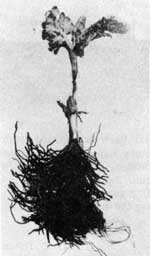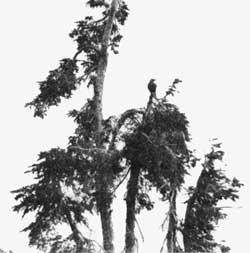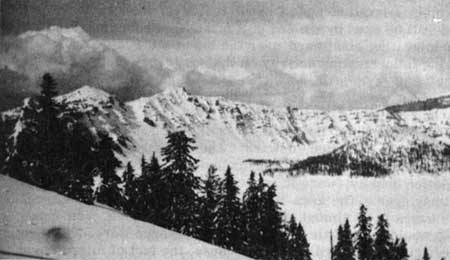Volume 17, 1951
All material courtesy of the National Park Service. These publications can also be found at http://npshistory.com/
Nature Notes is produced by the National Park Service. © 1951
My Search for Botrychium Pumicola
In the acute appreciation of the value and contribution of science towards modern life, the Westinghouse Electric Corporation and Science Service of Washington, D.C., have combined forces to ferret out talent of promise among graduating seniors in high schools all over the United States. This is known as the Science Talent Search that has been heralded in magazines and press. Basic requirements are: (1) a superior and versatile high school record, (2) a science aptitude test, and (3) study and performance of a significant scientific project. The reward is a scholarship in a science major in an American university of the contestant’s choice.
I had been extremely interested in entering this competition. Several projects passed through my mind before I took a job to help the ranger naturalists in the park. Immediately I was thrilled by the ideals of the National Parks and the varied, exciting possibilities for a project at Crater Lake. There is intense fascination in how plants came to the mountain after the climax eruption, how they have adapted themselves to the vicissitudes of the forbidding area, how they have succeeded in the various patterns that exist today. Then came the story of Botrychium pumicola told by one of the naturalists.
Here on the bleak summits of Llao Rock and Cloudcap, both buried in pumice scores of feet deep, are plant colonies and associations that have learned to get along in the intense sunlight, desiccating winds, cold nights, and bitter exposure, plants that because of their peculiar situation have acquired characteristics more closely akin to those desert types than to those of Alpine-Arctic members in similar high places. Here is found that delicate relative of the ferns with a tremendous root system and a single depauperate leaf that scarcely extends two inches above the soil: one of the rare plants of the world whose natural growing area may not even be the total of one acre.
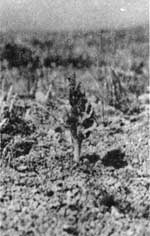 “…scarcely to be discerned against the drab background: Botrychium itself!” Approximately half life-size. |
Botrychium pumicola was discovered on the high open slope of Llao Rock by Dr. Frederick V. Coville, Chief Botanist of the U.S. Department of Agriculture in August, 1896. He discovered a second small colony on Cloudcap in 1902. Both of these localities are about 8000 feet in elevation. These two tiny plant islands were the only places in which the plant was known to grow until Dr. L. R. Detling of the University of Oregon collected it in 1928 on a summit just east of Paulina Peak near Newberry Crater. This is sixty miles northeast of Crater Lake from which it is separated by a pumice-covered surface of a lower and relatively flat elevation.
In this 1951 season that was early for plant activities, it was almost August before my plans for a project fully materialized. My initial search for the obscure plant was met with frustration. It proved to be annoyingly evasive. I had expected to find it sparse, but did not think that I should have to have my nose rubbed into it to discover what it looks like in the field. My initial trips to its home resulted in failure, but I would not give up. At last, when I began to doubt its existence it yielded: there it was in an exclusive and minute colony, perhaps fifty by twenty feet and resembling a crescent in shape. Its color of glaucous-green in its prime blends well with surroundings, and in the late season it had added a yellowish tinge that further diminishes its visibility. The slope on which it grows is gentle and close to the inside of the break that follows the crest of the prominence. The colony is 300 feet west of the benchmark on the summit that bears the legend, elevation 8046 feet. I noted in particular its associates which are few in number of species. Chiefly there are silver flower (Raillardella argentea), that odoriferous buckwheat well remembered by its name, dirty socks, (Eriogonum pyrolaefolium coryphaeum), and the interesting broom-rape (Orobanche fasciculata franciscana) that is parasitic on the buckwheats and polygonums.
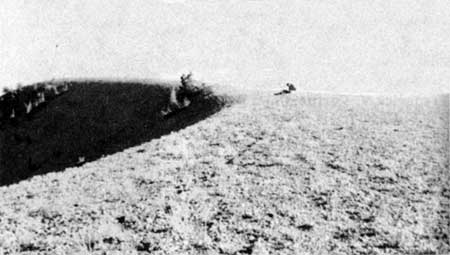
“…a likely looking crescentic ridge…”
It was now my fascination to make the trip to Newberry Crater to see if I could retrace Detling’s discovery. On September 7, I had my opportunity. On hands and knees, I scoured a likely-looking crescentic ridge southeast of East Lake. The dried remains of my friend Orobanche proved to be the decisive lead. Sure enough, there it was, its small and somewhat dried form scarcely to be discerned against the drab background: Botrychium itself! The lineal spread of the colony seemed great to me, being over 350 feet. In contrast, the greatest width appeared to be no more than five feet. The precise location of this colony is in T. 22 S., R. 13 E., Sec. 4. I ascended the ridge on a course due east from the car that was parked alongside a Forest Service section line marker that indicates that it is placed 350 feet south of the midpoint of the line between sections 4 and 5. To the south and practically on the level with the car is a pass over which the road winds and which is given an elevation of 7176 feet on the map. I estimated our colony to be 300 to 500 feet higher. Later I learned that Dr. Detling’s collection was made on a summit west of the road.
From my high place, the summits of the Cascades looked so near and alluring. Could it be that Botrychium might find a home there, too? Little chance of such occurrence, but nevertheless, there I wandered two days later. The first locality of promise was the rounded top of Tumalo Mountain on which perches a Forest Service fire-lookout at its apex, 7772 feet. The soil, though the familiar fine pumice with a cover of coarse pumice- mulch, looked somewhat different, having a reddish hue caused by an admixture of ash of that color. The familiar indicators were there, but the most numerous member of the colony was Anemone globosa, that was absent in the other three localities in which I discovered Botrychium. Here, as elsewhere, Raillardella was the most encouraging lead. I scrutinized the whole summit area on my hands and knees, hoping against hope that the small treasure might be my reward. The entire dismal start of my search for the fern passed through my mind’s eye. It was so improbable, and the efforts seemed so futile. But no! There it was: a single specimen growing scarcely an inch above the ground 80 feet due north of the lookout whose location is in T. 18 S., R. 9 E., Sec. 10. But despite piercing search and dogged persistence, only one other plant could be found, scarcely twenty feet away from the first specimen.
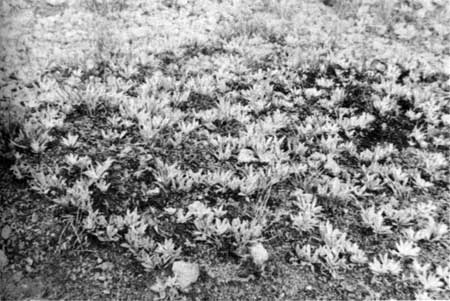
“…patch of Raillardella examined with tireless care.”
In that afternoon of September 9, I made a sortie up a likely-looking ridge leading northeast from Broken Top. Higher and higher led the search, later and later grew the hour. Each patch of Raillardella was examined with tireless care. Already the highest elevation had been passed at which the plant had been found elsewhere. Prospects and light were growing dimmer, and an autumn chill gripped the darkening landscape. It was imperative that I start down the grim crags. Then in the gloom of faded light and hope, a single stem shimmered out of the bare soil, attended by a complete circle ofRaillardella, a few feet in diameter. It was the capping triumph of my great day! The exact locality of my find is T. 17 S., R. 9 E., Sec. 20, at an elevation of over 8500 feet!
The collected specimens were pressed and prepared for mounting. I sent the Cascade prizes and examples from the other three localities for study and positive identification to Dr. Robert Clausen of Cornell University, the celebrated expert on OPHIOGLOSSACEAE to which Botrychium belongs. I donated other specimens to the herbarium of the University of Oregon which is under the direction of Dr. L. R. Detling. A report of their conclusions should follow in a future number of NATURE NOTES.
Pack Rats
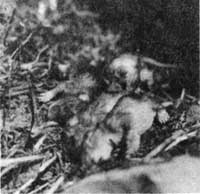 “The youngsters…had dainty pink noses and feet.” |
The naturalists had been annoyed by an unknown nightly visitor to the Information Building during the month of July, that left disorder in its wake. The flowers so carefully arranged for display were chewed off and scattered in distant parts of the room. Traps in numbers were set for the villain, but they were untouched during the night. Tidbits of cheese, candy, peanut butter, even the flowers so avidly stolen from the display table would not entice the pilferer to his capture.
The end was sudden; a female pack rat was discovered in the wood pile on July 31 and was quickly dispatched. But this did not make an end of the episode. The next morning, upon opening the building, we heard hungry squeals coming from above. Upon investigation, the rat’s nest was found upstairs and within it four babies. The heterogeneous components of the structure included four of the traps that had been set out, two large signs used on the self-guiding nature trails, bits of rocks, paper and wood. The interior was snugly lined with fur from the mother and small pieces of newspaper.
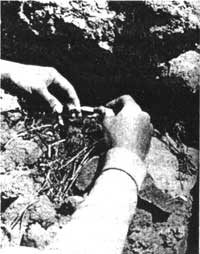 “They were fed cream sweetened with syrup through a medicine dropper to which they clung with eagerness.” |
The youngsters, only two or three days old, with pelage still matted, had dainty pink noses and feet. The eyes had not yet opened, nor did they open during the next three days of pampered but forced residence at Park Headquarters. The young measured two inches in length with naked tails about three-quarters of an inch long. They were fed cream sweetened with syrup through a medicine dropper to which they clung with eagerness. A small feeding was required at least every half-hour, but my maternal efforts were insufficient to sustain the delicate thread of life within them. After all, they had endured a long day’s hunger when mother had made her demise.
The flowers now remain undisturbed on the display table during the night. No longer need the naturalists go afield each morning with vasculum under arm in search of fresh blossoms to show park visitors. The benefits of the nocturnal rearrangement and disposal have come to an end, but another yarn has been added to the many involving this character of prankish caprice.
Muskrat Record
On August 8, 1951, I found an adult muskrat on the park highway four miles north of the South Entrance. Apparently it had been hit by a car as it was attempting to cross the road. As Annie Creek nearby has cut a deep canyon with sheer walls, it seems quite unlikely that the animal was making that creek its home. Muskrats are known to rove or migrate considerable distances in the fall. Possibly this individual was in search of a new home.
Butterflies of Crater Lake National Park
An early collection of butterflies of Crater Lake National Park was made by Dr. H. A. Scullen in 1930 who served as a ranger naturalist that year. No attempt is made to give a complete list of park butterflies here, for a comprehensive collection should yield fifty to a hundred different species. A short discussion is given of the specimens collected by Scullen and those observed by me in the park during the past summer. The butterflies are to be commonly found in several general localities. Principally they are abundant on and in the vicinity of flowers. Secondly, they are likely to be found near streams and in moist places where they try to imbibe water from the wet earth.
Among more common species captured or observed are the following: Western Parsley Swallowtail, Parnassius, several whites and sulphurs, satyrs or wood-nymphs, fritillaries, checker-spots, angle-wings, California Tortoise Shell, Mourning Cloak, Painted Lady, Admiral, Nivalis Copper, several species of little blues, and several skippers.
The California Tortoise Shell was the species that most captured the attentions of park visitors this year. Beginning before August 1, this butterfly appeared in vast numbers on the slopes of Mt. Mazama. The same phenomenon had occurred in 1930 and 1931 according to park records, as well probably as in intervening years when no note was made of the irruption. California lilac or snowbush (Ceanothus) is the food plant of the larvae. 1951 must have been an exceptionally propitious season for these insects, for they developed in vast numbers. The main migration lasted about ten days, though many specimens could still be seen by the end of August. On September 5, hordes were seen migrating southward over the top of Mt. Scott. They were performing in interesting activity on the south rock slope of Mt. Thielsen where I saw them still in abundance on August 20. Many had secreted themselves beneath the rocks, from which they would pop out and fly away as I disturbed them by walking over their retreat.
Most of the time, the tortoise shells were flying in great numbers mainly in one direction, upward. The significance of such migration is not understood, though presumably the females, forced outward by population density, were in search for host plants on which they could lay their eggs. The area in which adults emerge has been shown in some cases to be almost entirely denuded of leaves. Consequently the young would have little on which to live if eggs were deposited in the same vicinity. Regardless of the cause, the fact of migration or wandering has impressed observers during years when conditions are right for its occurrence.
Many species of butterflies are found at high altitudes in the vicinity of the rim, 6000 to 8000 feet, that do not occur elsewhere. Of these, three species, Parnassius, Nivalis Copper, and Pine-white, were collected and frequently seen this year.
The larvae of Parnassius feed on stonecrop (Sedum) and saxifrage which are common plants at high altitudes. The adults are quite common, flitting around the trails and meadows from Tulare County, California into Oregon. It is a white to cream-colored insect with black spots and short black bands on its front wings and a pair of small red or orange spots bordered with black on each hind wing. The wing spread is about two and a half inches.
The pine-white, also mainly a high altitude form, is likewise white in color, but much smaller (1-3/4 inches wing spread) and having only black markings. A black band on the forward edge of the front wings extends from the body about half way out to the side where it curves inward towards the center of the wing. The tips of the fore wings are black with an enclosed white pattern. The remainder of the wings are marked only lightly with dusky scales along the wing veins. The larvae feed on pine trees. When ready to change to the adult stage, the larva lets itself down to the ground by a long thread. In the ground, it goes into the pupal stage to emerge the next spring as the adult butterfly.
The following list arranged in taxonomic order, includes the species of which specimens have been collected or definitely identified in the field.
Western Parsley Swallowtail – Papilio zelicaon Lucas
Parnassius – Parnassius clodius baldur Edw.
Pine White – Neophasia menapia F & F
Becker’s White – Pieris beckeri Edw.
Common White – Pieris protodice vernalis Edw.
Boisduval’s Sulphur – Eurymus eurytheme Bdv.
Wood Nymph – Cercyonis alope Fabr.
Fritillary – Argynnis sp.
Segregated Checker Spot – Melitaea hoffmanni segregata B & McD.
Angle Wing – Polygonia faunus Edw.
California Tortoise shell – Aglais californica Bdv.
Milbert’s Tortoise shell – Aglais milberti Godt.
Mourning Cloak – Aglais antiopa Linn
Virginia Lady – Vanessa virginiensis Dru.
West Coast Lady or Malva Butterfly – Vanessa carye Hon.
Lorquin’s Admiral – Basilarchia lorquini Bdv.
Nivalis Copper – Heodes nivalis Bdv.
Acmon Blue – Plebeius acmon West. & Hew.
Banding Crows and Jays
A banding program was begun in the summer of 1950 in order to understand better the behavior and movements of park crows and jays. Besides the standard, numbered, aluminum bands supplied by the U.S. Fish and Wildlife Service, most birds were marked with additional bands of several colors, so that each individual could be distinguished by his distinctive combination. This eliminated the necessity of retrapping for identification. To compare wear among the aluminum bands, a few birds were given two bands of this kind.
CANADA JAY, Perisoreus canadensis (Linnaeus)
Thirty Canada jays have been banded at our cabin at park headquarters and at Annie Spring during the past two summers. Of the twelve taken in 1950, one was banded at Annie Spring where it shared campers’ breakfasts and was most easily enticed by bread as bait. Two of the ten captured at our cabin had been banded previously by M. R. Mewalt in December, 1948. Colored bands were added to their standard bands for easy recognition. As our trap was set almost continuously, eight of the ten were taken more than once: five were retaken a second time, two were retrapped twice, and one individual was caught an additional four times. This is a different pattern from that of juvenile Steller jays that discovered the trap a very easy way to get food and were retrapped very frequently.
Of eighteen Canada jays captured in 1951, four were banded at Annie Spring Campground within an hour. Two of fourteen taken at our cabin had been banded in December, 1948 and were given the extra identifying bands. Six of the 1951 birds were retrapped; three were recaptured a second time; one was captured two additional times; the other two entered the trap three more times. Three banded in 1950 were retrapped in 1951, but only one of these had been retrapped in 1950. Apparently these three individuals had forgotten about the trap during the winter. Once retrapped in 1951, they remembered their lesson and did not enter the trap again. As soon as all of these jays that came to our feeding platform in 1951 had been banded, the trap was no longer set. Thus it is impossible to compare retrap figures for the two years.
The behavior of the Canada jays on the feeding platform in the presence of Steller jays is very interesting. The Canada jay is the smaller and less aggressive bird and does not eat or alight on the platform while the Steller jay is feeding. However, a change took place in this behavior at the end of the 1951 banding period. A number of juvenile Steller jays moved into the area the last week in August and began using the feeding platform regularly. By this time the Canada jays apparently had come to consider the platform their personal property, for they did not show the newcomers the usual respect. In fact, while they do not actually drive their competitors away, they do come and eat at the same time, and frequently when two or three of them arrive simultaneously the Steller jay is forced to leave.
A further problem in competition was added by the ability of one golden-mantled ground squirrel to jump from the ground onto the feeding platform. Other squirrels try it with most amusing results as they fail, sometimes by as much as eight or ten inches, and land in most undignified positions. On August 30, 1951, following two days of snow and rain, the Canada jays were extremely eager for food. When I put some out and pounded the can against the metal food platform, a sound which they have learned to identify with a replenished supply of food, not only the jays appeared but also the squirrel. The latter leaped onto the platform and began eating. The jays were hungry; one after another they landed on the platform and, facing the squirrel, ate with him. Finally, with three jays on the platform, they rushed the squirrel as though a signal had been given, causing him to retreat in great haste.
STELLER JAY, Cyanocitta stelleri (Gmelin)
When the banding trap was set and baited in 1950, a family of Steller jays made use of it as one of their main sources of food a large portion of the time. There was a great deal of snow in June and even July that year. Our first two banded Steller jays were adults which we banded June 15 and which we saw frequently during the remainder of the summer. They often came to the feeding platform and tried to get food from the trap by putting in their heads, while refusing to step inside. On July 19 we banded the first of several juveniles which we eventually identified as belonging to this family group by establishing which juvenile was begging from which adult. Those young became our star boarders.
In all, we banded six adults and four juveniles at the cabin in 1950. Three of these were retrapped once, one was retrapped nine times, two were retrapped 15 times, and one was retrapped 24 times. On August 5, 1950, a juvenile which had been banded on July 19, 1950, was retrapped five times in one day. All of the juveniles became so accustomed to the trap and to the procedure for release that when they heard the back door slam, a sign that someone was coming to release them, they ate with greater speed in order to get as much food as possible. When I came within a foot of the trap they stopped eating and started clinging to the wire sides of the cage farthest from the door. When I actually had my hand in the cage they made a few feeble flaps of their wings, much as a juvenile does to attract the attention of the parent bird when it wishes to be fed. They took as a matter of course the reading of the band number before release and made not the slightest effort to escape.
In 1951 we banded two adults and nine juveniles. Only one of these was retrapped and none of the birds banded in 1950 was retrapped. However, we do have 1951 sight records for two of the birds banded in 1950.
CLARK NUTCRACKER, Nucifraga columbiana (Wilson)
For reasons not yet fully understood, 1950 was a year in which Clark nutcrackers flocked to the rim area at the head of the lake trail and from there to the lodge in very large numbers. On the first morning that banding was attempted, the trap was set up in the vicinity of the wall not far from the Information Building and to the west of the walk to Sinnott Memorial. In one hour and a quarter, ten nutcrackers were banded. But when half an hour passed without further birds, a better location was sought and found beneath some dead trees at the head of the lake trail. For the rest of the summer, all banding at the Rim was carried on at that spot and an average of one bird per five minutes was maintained.
One hundred and sixty five nutcrackers were banded in 1950; one of these was banded at Annie Spring Campground, 5 at the cabin at park headquarters, and 159 at the rim. One of these birds had been previously banded with a wire ring which gave no information except that the bird had been seen during the winter of 1948-1949.
The sight records showed some very interesting things about the birds. There were eight birds among those we had banded that regularly went to Annie Spring Campground for breakfast. We first became aware of this when we encountered an “educated” nutcracker at the campground. Foolishly, we had attempted to bait the trap with peanuts just as we did at the Rim, only to discover that the Annie Spring birds were avian “country bumpkins” who did not know how to eat peanuts. They took each peanut and after examining it several times broke it into many small pieces and spent ten minutes eating the peanut piece by piece.
They were much more interested in bread, bacon, potatoes, and butter. When we found one that was “sophisticated” enough to swallow peanuts whole, as it was done on the Rim, we had much less trouble in trapping him. He had obviously been corrupted by the birds on the Rim. Further observations showed that there were eight birds which appeared at Annie Spring for breakfast, that arrived at the Rim about 9:30 AM for their share of the peanuts to be obtained there.
Of the 159 birds banded on the Rim in 1950, 120 were seen again that year. Two not seen again in 1950 were seen in the following year. Nineteen were seen both years. Four of the five banded at our cabin were eventually seen at the Rim; three banded at the Rim were seen as far away as the Watchman and fourteen were retrapped. Two of these were retrapped a second time, but none was ever captured more than three times.
The most interesting record of all of the nutcrackers banded in 1950 came to us because a hunter read the band. This man had shot at an owl on Mount Adams, Washington, and although he missed it, had seen it drop something that it was carrying. He investigated and found out that it was one of the Clark nutcrackers that we had banded a month and a half previously (September 1, 1951) here in Crater Lake National Park.
The small baseball-minded member of our family spent part of his time during the summer pitching peanuts to the nutcrackers. When, toward the end of the summer, he reported that he had found a nutcracker that could catch peanuts, we were doubtful, but investigation proved that one of the banded birds could do just that. This nutcracker would stand about five feet away and point his bill directly at the individual holding the peanuts. A peanut tossed within several inches of his head was caught without difficulty. If the peanut were thrown so that he could not catch it he paid no further attention to it and allowed one of his less accomplished companions to scramble for it. We immediately started tossing peanuts to all the nutcrackers that were around but we never found another one which would catch them.
Banding in 1951 was a very different matter. There were days when it was impossible to see a single bird between the lodge and the head of the lake trail, although occasionally one could hear them even when they were not present along the Rim. The nutcrackers showed a considerable indifference to peanuts; very few of the birds even knew how to eat them. In all, we banded 36 nutcrackers in 1951, all of them in the Rim and Rim Campground area. We have sight records for exactly half of these. This remarkable decrease probably does not indicate a decrease in total nutcracker population in the park, but rather a wider and more even dispersal because of the abundance of natural food in terms of the excellent cone crop in several species of trees.
Other pages in this section


